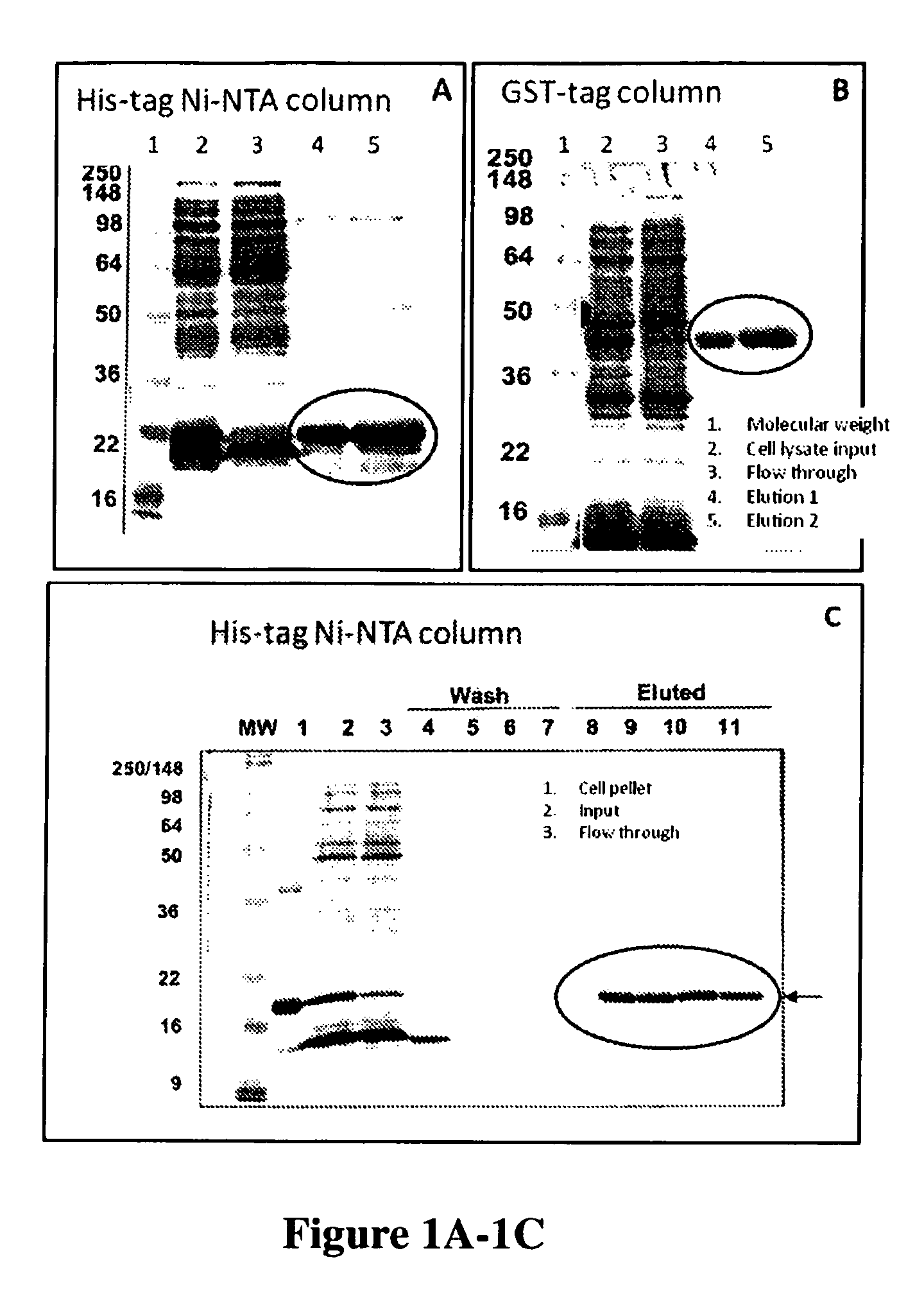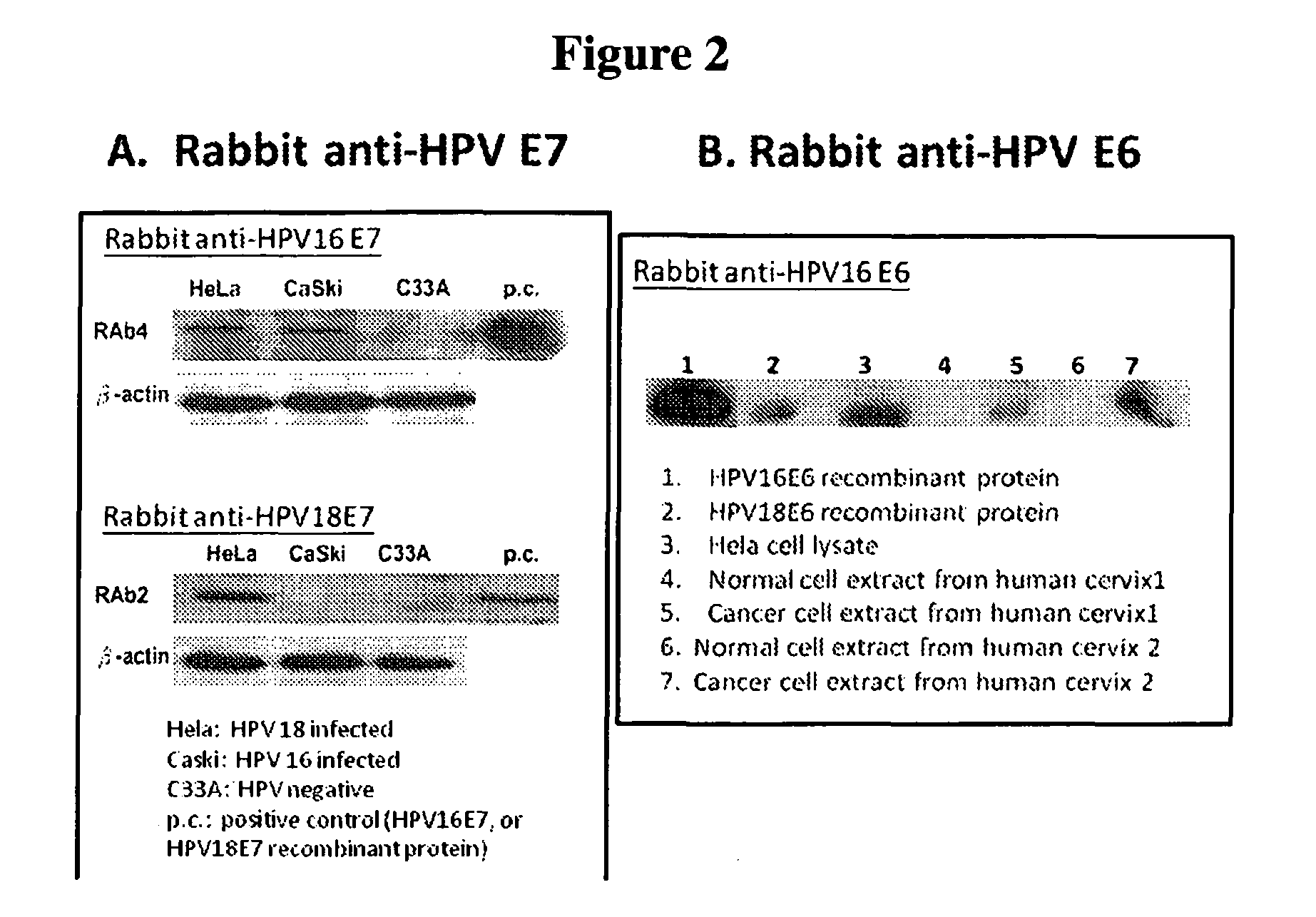High throughput cell-based HPV immunoassays for diagnosis and screening of HPV-associated cancers
a cell-based, high-throughput technology, applied in the direction of instruments, biochemistry apparatus and processes, material analysis, etc., can solve the problems of low sensitivity and high false positive rate, and the inability to detect high-grade cancers in cervical biopsies. the effect of 33% to 50% of high-grade diseas
- Summary
- Abstract
- Description
- Claims
- Application Information
AI Technical Summary
Benefits of technology
Problems solved by technology
Method used
Image
Examples
example 1
HPV Recombinant Protein Expression, Purification, and Preparation to be Used as Immunogens for Generating Antiserum, and Screening for Monoclonal Antibody from Hybridoma Cell Lines
[0158]HPV recombinant proteins can be any kinds of HPV proteins, HPV proteins of early genes and / or late genes, including, but not limited to, E2, E6, E7, L1, L2 and can be from various HPV types. One aspect of the invention provides recombinant proteins, such as recombinant hybrid proteins containing a partial sequence or a full length sequence of HPV oncogenic proteins. For example, full-length E6, E7, and / or L1 polypeptide sequence, which have been found very difficult to obtain and purify due to undesirable aggregation during protein purification, protein instability, low levels of expression, low immunogenic responses of purified proteins. For example, many early E6 oncoproteins contain many cysteine amino acids and thus the correct topography of the E6 oncoproteins requires formation of many disulfid...
example 2
Anti-HPV Antibody Preparation
[0167]Recombinant HPV proteins produced using the techniques as described in Example 1 were used as immunogens for generating antiserum, polyclonal antibodies, and monoclonal antibodies.
[0168]The basic techniques for cloning and for conducting the immunological assays can be found in “Antibodies: A Laboratory Manual”, Harlow and Lane, Cold Spring Harbor Laboratory, Cold Spring Harbor, N.Y. 1989; “Molecular Cloning”, A Laboratory Manual, eds. Sambrook, Fritsch and Maniatis, Cold Spring Harbor Laboratory Press, 1989, and others books and manuals known in the art. Details of our procedures for antibody production the characterization of the produced antibodies, and certain assays are described in co-owned U.S.
[0169]U.S. Pat. No. 8,865,162, filed on Jun. 10, 2009, titled “Novel Monoclonal Antibodies against HPV Protein,” U.S. Pat. No. 8,859,218, filed on Jun. 10, 2009, titled “In situ Detection of Early Stages and Late Stages HPV Infection,” U.S. Pre-Grant P...
example 2.6
The Specificity of Anti-HPV Antibodies
[0171]One or more immunological assays can be used to test the specificity of the monoclonal antibodies generated by screening the hybridoma cell lines with two or more HPV recombinant proteins. EIA (Enzyme Immuno Assay) and / or Western blots were used as the assay format to test the specificity of the HPV antibodies described herein. Various purified recombinant HPV proteins, including the original screening proteins used for obtaining the anti-HPV antibodies and other proteins not used for screening, were used to coat on the microtiter plate to test the specificity of the obtained anti-HPV antibodies on EIA. Proteins in cell lysate from cervical cancer cell lines (with or without HPV infection) were also used to test the specificity of the anti-HPV antibodies by western blot. To confirm the binding and reactivity of the HPV antibodies with proteins from HPV infected cell lines, western blot is very useful to demonstrate specific protein bands c...
PUM
| Property | Measurement | Unit |
|---|---|---|
| pore size | aaaaa | aaaaa |
| dissociation constant | aaaaa | aaaaa |
| concentration | aaaaa | aaaaa |
Abstract
Description
Claims
Application Information
 Login to View More
Login to View More - R&D
- Intellectual Property
- Life Sciences
- Materials
- Tech Scout
- Unparalleled Data Quality
- Higher Quality Content
- 60% Fewer Hallucinations
Browse by: Latest US Patents, China's latest patents, Technical Efficacy Thesaurus, Application Domain, Technology Topic, Popular Technical Reports.
© 2025 PatSnap. All rights reserved.Legal|Privacy policy|Modern Slavery Act Transparency Statement|Sitemap|About US| Contact US: help@patsnap.com



